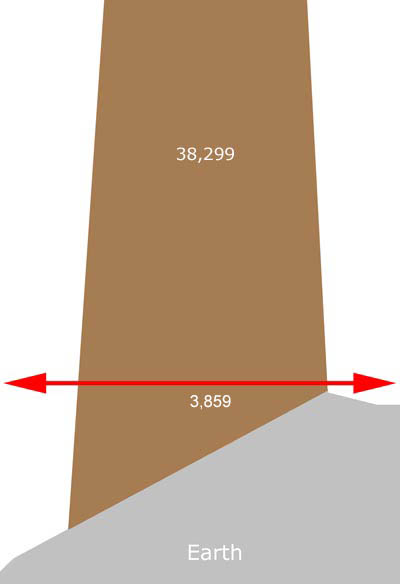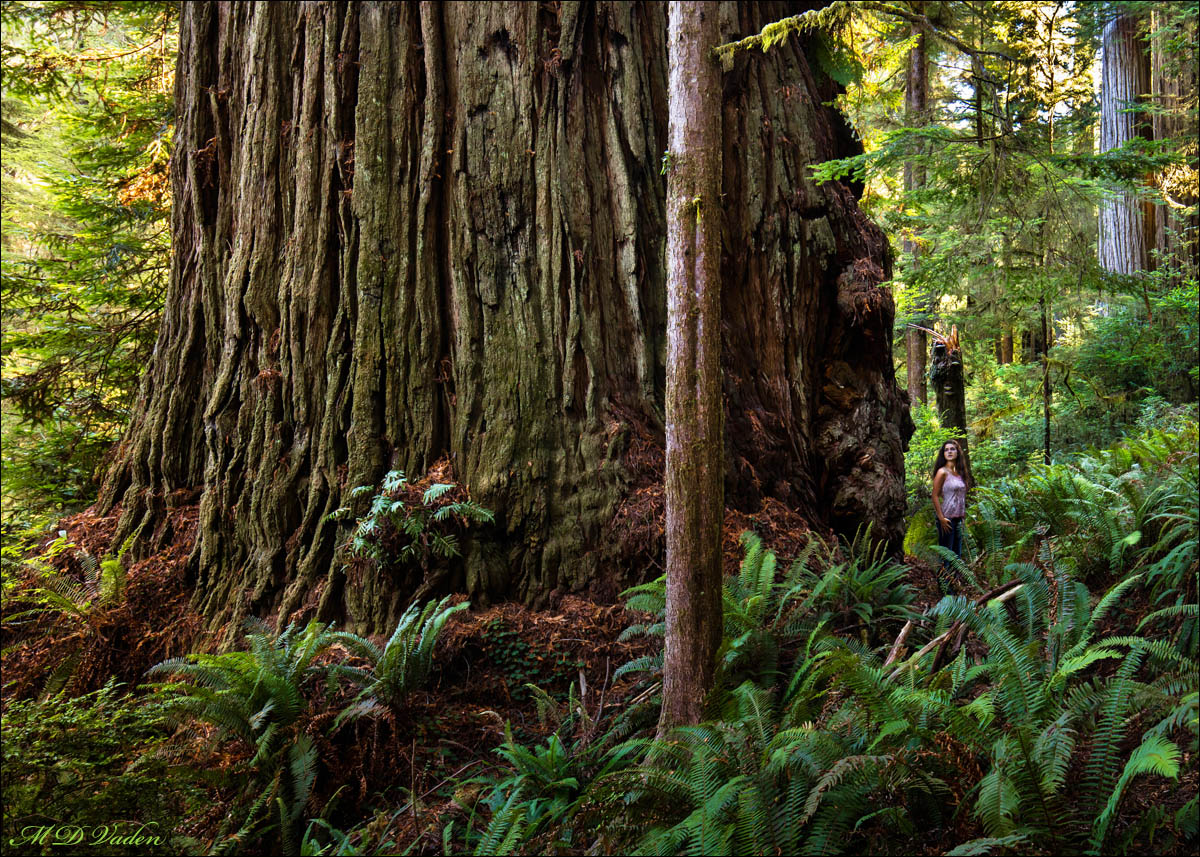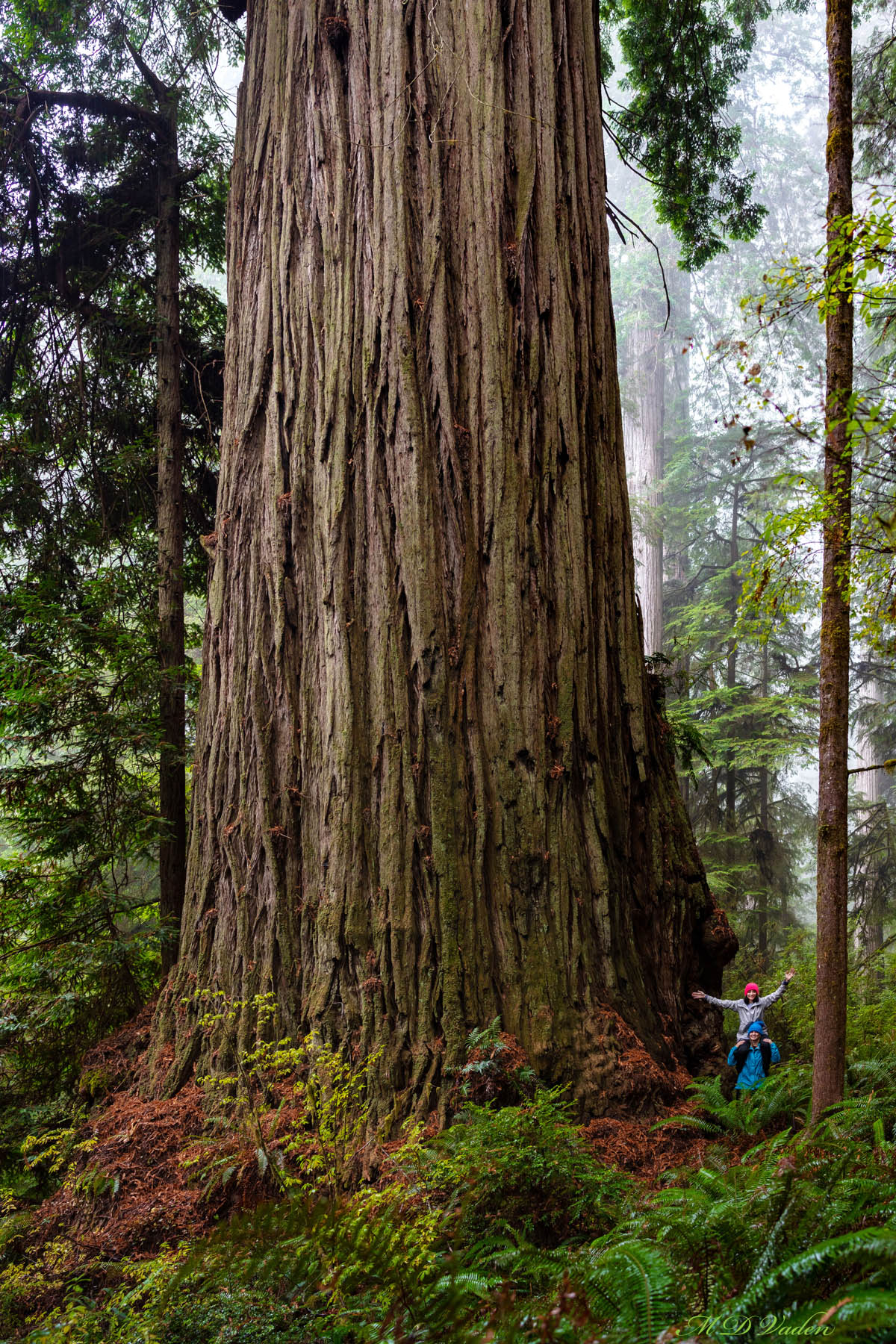Diameter was measured several times for several purposes. Michael Taylor and one other person measured diameter, but subjective. They confirmed estimating an imaginary line through a bulky section of trunk. There is about 11 feet difference between the high and low sides which were averaged. The nationally recognized formula for points adds height + girth + 1/4 crown. I used Chris Atkins height measurement. Average diameter at dbh is 27.38 ft.. The diameter was as objective as possible. Technically, I could have lowered the tape a few more inches on the downslope side but doing so would have unrooted sorrel and ferns. If the tape was lowered at the sacrifice of plants, estimated average dbh is 27.63 ft.. It's better to spare plants and be content with 27.38.
The age estimate used to be 3000 yrs. gauged from fallen redwoods and growth rings. Prior to 2014, Ron Hildebrant counted upwards of 2000 rings on fallen trunks he found. December 2018, he sent a letter about 8 fallen coast redwoods (2014 - 2018) over 3000 years, each smaller than this discovery. Based on those new findings, I changed this redwood's age estimate to over 4000 years. If trunks 1/2 to 2/3 this size can live 2000 to 3000 years, isn't even 5,000 years or more possible? Until 2013 the oldest tree was a bristlecone pine (5,062 years). Between this coast redwood and another discovery named
Déjà vu, there's a chance one coast redwood is as old or older. Ron's meticulous findings are one more example that what people find on-the-record at "official" sources does not reflect all that's known.
On the final measure, I found extra reach of trunk on the low side beneath loose needles that others did not reveal previously during Chris's measure. That extra reach increased total height slightly and lowered the elevation for the average dbh diameter. That increased diameter inches and points. Soil was not moved, just needles lifted and trunk revealed.
It's worth noting this Big Kahuna redwood was found prior to getting a permit. So even though it was described in a 2014 research permit report as an added favor to the parks, my hands are not bound about sharing the photo or dimensions.
www.curlyredwoodlodge.com (707) 464 - 2137 @ 701 Hy. 101 S. Crescent City, CA 95531. Click photo for more .. 8 / 2014
Spring
September 2016 was a dry summer with virtually no rain June - September. It was a surprise to approach early autumn and feel boots sink ankle-deep into saturated earth a few hundred feet away. A hidden spring was revealed. That partly answered how this redwood could become so robust. This is similar to areas near Orion and Episkopos. The presence of spring water further debunks a super-DNA hypothesis that some people promote about largest coast redwoods. Clones from the largest existing should not surpass growth of redwoods from seeds or tissue of random coast redwoods.
Name
The first name for this redwood was Spartan, then later we decided to go with Grogan's Fault a variation of the geological fault along Redwood Creek, dividing Redwood National Park. Eventually we reverted to the original name Spartan after realizing the age and tenacity for survival. So both names are correct. Grogan's Fault is the name used at conifers.org where Chris Earle refers to our discovery. This may be a good point to interject that Spartan is one of the redwoods Dr. Sillett talked about when a news story quoted him knowing of "larger trees elsewhere" (Statesman Journal Article)
Some people have misinformed on social media that Spartan is the Prairie Creek redwood Juggernaut. There is no resemblance. That Prairie Creek redwood also known as Colossus, stands in plain sight, known for decades. G. F. Beranek uses the name Colossus, and may be in one of his 6 redwood books. That other redwood is along Drury Parkway north of Orick. To further iron wrinkles, this Collosus is not the same redwood as the Super Collosus, also in Prairie Creek park but in a valley of lost groves.

Update
April, 2017, I got a copy for volume measurement with diameters every 10 ft. increment of height. The data starts at "0" elevation with 24.9 ft. as diameter. That suggests diameter about 2 ft. above the upslope side and connotes our math Guru's 38,299 cu. ft. is minus the the trunk wedge reaching 11' - 13' lower on the downslope. He is known as conservative. I do not believe anything below the red line is reflected in his data sheet for laser measures from 4 different sides.
The huge extra wedge of trunk can add near 3,859 cu. ft. and combined with 38,299 total volume of the main trunk may be 42,059 cu. ft. not counting reiterations. Knowing Ron's conservative tendency even 44,000 cu. ft. is conceivable. Including reiterations I cannot tell beyond that whether the redwood is 44,000, 45,000, etc.. Full volume with reiterations remains a partial mystery.
At a height of 60 ft. the trunk is approximately 17 feet diameter and at 240 ft. is 8 feet thick. The crown spans approximately 110 ft. wide between farthest branch tips.
There is hardly any damage. This is a trait some of the largest titans have in common around the base area.
The crown has typical gnarl and sculpting from countless storms but otherwise looks rock solid.
There are several reasons we discovered some of these new titan redwoods ahead of most other people. An obvious reason was spending more time looking plus extra experience with redwoods and measuring. Between 2010 and 2018, a few folks started directing people via social media to redwoods like the Grove of Titans, claiming those areas had the largest redwoods. While gawkers flocked to those areas, we dispersed to several parks in every other direction racking up discovery after discovery. Even today, nobody other than the small core of redwood explorers really knows where the largest and tallest discovered redwoods stand.

advertisement
Images: The thick canopy is like a forest above the forest. It has foliage to near ground level, making it one of the tallest canopies on Earth. The foliage spans about 308 feet top to bottom. The first photo was taken November 2018 during a rain storm showing a couple of Redwood Elves for scale. It's a good example of standing off the trunk and sparing small vegetation by walking was on fallen needles. In fact, they are on a small bear trail that passes near the trunk. The image above was taken in 2016.
The other image below is about ninety degrees different and looking uphill. This side's lack of included bark creases further shows the the single trunk form or this redwood titan. Contrary, distant images of Sherman Sherman Sequoiadndron over in a mountain grove show long continuous included bark indents from double stems.








